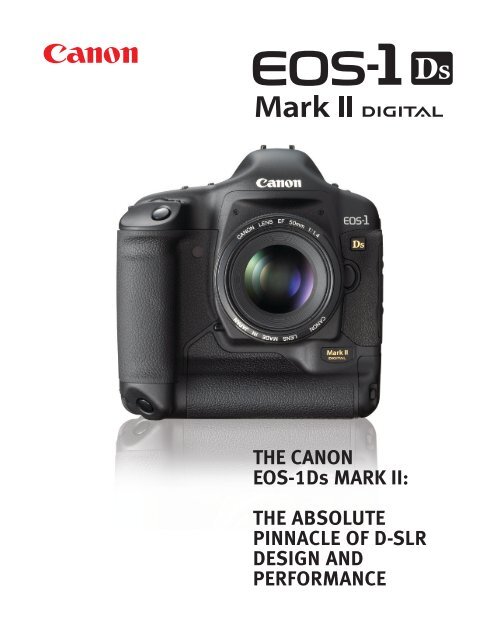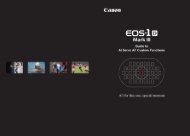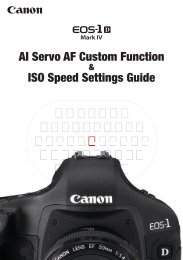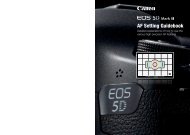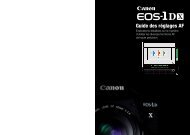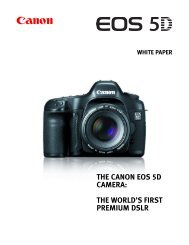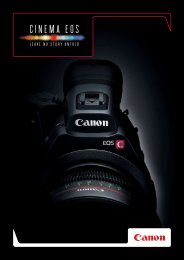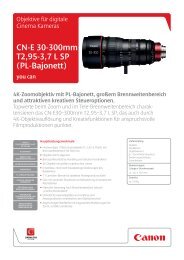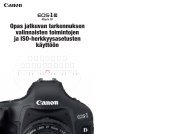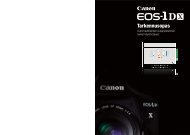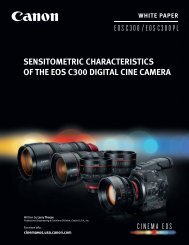Canon EOS 1Ds Mark II White Paper - Canon Professional Network
Canon EOS 1Ds Mark II White Paper - Canon Professional Network
Canon EOS 1Ds Mark II White Paper - Canon Professional Network
- No tags were found...
Create successful ePaper yourself
Turn your PDF publications into a flip-book with our unique Google optimized e-Paper software.
CTHE CANON<strong>EOS</strong>-<strong>1Ds</strong> MARK <strong>II</strong>:THE ABSOLUTEPINNACLE OF D-SLRDESIGN ANDPERFORMANCE
Table of Contents I OVERVIEW 3<strong>II</strong> SUMMARY OF FEATURES 5Performance 5Controls and Display 6Body and Exterior 6Compatibility and Support 6Software and Accessories 7<strong>II</strong>I NEW AND IMPROVED DESIGN FEATURES 8New and Improved Design Features 8New 16.7 Megapixel CMOS Sensor 8Autofocus System 9E-TTL <strong>II</strong> Flash System 10Exposure Control 11DIGIC <strong>II</strong> Image Processor 12Speed of Operation 12Recording Controls 12Color Materials 13Processing Parameters 13<strong>White</strong> Balance 13Dual Slot Memory Cards 14Data Loss Protection 15Reliability and Durability 15Ease of Operation 15Playback Features 16High Resolution LCD 16Camera Setting Retention 17Image Protection/Erase 17Drive System 17Connectivity 17Audio Recording 18Direct Printing 18IPTC Compatibility 18Exif 2.21 Compatibility 18Software Package 19Wireless File Transfer 20Data Verification Kit 20IV SPECIFICATIONS 21V CONCLUSION 25
I. OVERVIEWThe <strong>Canon</strong> <strong>EOS</strong>-<strong>1Ds</strong> <strong>Mark</strong> <strong>II</strong>, brother of the <strong>EOS</strong>-1D <strong>Mark</strong> <strong>II</strong> andsuccessor to the <strong>EOS</strong>-<strong>1Ds</strong>, is the new flagship of the <strong>Canon</strong>line of digital single lens reflex cameras and the absolutepinnacle of D-SLR design and performance.The <strong>Canon</strong>-designed and manufactured full-frame CMOSsensor has 16.7 megapixels, the highest resolution unit inany digital SLR on the market. Complete, in-house controlhas made it technically and economically feasible for<strong>Canon</strong> to produce a sensor of such prowess.Amazingly, the <strong>1Ds</strong> <strong>Mark</strong> <strong>II</strong> is lithe and responsive. <strong>Canon</strong>has given it the processing power and write speedsnecessary to handle the enormous files it records soeffortlessly. The <strong>EOS</strong>-<strong>1Ds</strong> <strong>Mark</strong> <strong>II</strong> can fire bursts of 32JPEGs or 11 RAW frames at 4 frames-per-second. It startsfrom OFF in 0.3 second and has a shutter delay as low as40ms. The <strong>1Ds</strong> <strong>Mark</strong> <strong>II</strong> shares its exceptional 45-pointautofocus system, E-TTL <strong>II</strong> flash system, extensive controls,rugged chassis and shutter with the <strong>EOS</strong>-1D <strong>Mark</strong> <strong>II</strong>, the professional standard forsports, news, fashion, wedding and portrait photographers worldwide.This commonality of parts has enabled <strong>Canon</strong> to offer a vastly improved camera for thesame price as its 11.1 megapixel predecessor. For approximately $8,000, the <strong>1Ds</strong> <strong>Mark</strong><strong>II</strong> equals, and surpasses in many respects, the performance of digital camera backs thatcost $16,000 and up, plus the purchase of a medium format body. Then factor in thelimited selection and expense of medium format lenses and accessories and theinconvenient add-ons most backs require. At $7,999, the <strong>1Ds</strong> <strong>Mark</strong> <strong>II</strong> may not beinexpensive, but it is a sensational deal.The <strong>EOS</strong>-<strong>1Ds</strong> <strong>Mark</strong> <strong>II</strong> will appeal immediately to photographers who do commercialproduct shots, stock photography, portraits and landscape work. Weddingphotographers who sell large prints, or who have wanted to, and magazinephotographers shooting covers, full-page layouts and centerfolds will love it, too.Photographers who have used the <strong>EOS</strong>-<strong>1Ds</strong> will be delighted with the new resolution ofthe <strong>1Ds</strong> <strong>Mark</strong> <strong>II</strong>, but they will find the new speed and ease of operation a pleasure aswell. It is likely that the steady rate of conversion of pros from other systems willcontinue and possibly accelerate.I. OVERVIEW 3
<strong>II</strong>. SUMMARY OF FEATURESPerformance• World’s highest pixel count in a 35mm, full-size digital AF SLR camera• 16.7 megapixel, full-size, single-plate CMOS sensor, designed and manufactured by <strong>Canon</strong>• Continuous shooting speed of 4 fps (One-Shot AF/AI SERVO AF) with a maximum burstof 32 shots in JPEG large or 11 shots in RAW (vs. 3 fps and 10-shot maximum burst forall pixel counts with <strong>EOS</strong>-<strong>1Ds</strong>)• DIGIC <strong>II</strong> Image Processor with 8-channel reading and DDR-SDRAM for fast processing,fine detail and natural color reproduction• Uses 45-point area AF unit with 7 cross-type sensors, E-TTL <strong>II</strong> flash system and21-zone light-metering sensor• Startup time is an exceptionally fast 0.3 sec., compared with 0.5 sec. for the 1D <strong>Mark</strong><strong>II</strong> and 0.6 sec. for the <strong>1Ds</strong>• Release time lag 55ms (40ms with maximum aperture set via Personal Function) andviewfinder blackout time 87ms, same times as <strong>EOS</strong>-1D <strong>Mark</strong> <strong>II</strong>• Increased battery performance• Shorter media write times• Color reproduction improved to give richer, fuller colors while maintaining traditional<strong>EOS</strong>-1D series emphasis on fine color gradations• False colors (aliasing artifacts) minimized by new 3-layer optical low-pass filter• Same low-noise characteristics as <strong>EOS</strong>-1D <strong>Mark</strong> <strong>II</strong>• Selectable dark noise subtraction for long exposures• Full-size sensor takes full advantage of lens performance, including wide-angle lenses;no focal length conversion factor• Shutter speeds: 1/8000 to 30 sec. and bulb exposure• Maximum X-sync speed 1/250 sec.• Shutter endurance increased to 200,000cycles, same as 1D <strong>Mark</strong> <strong>II</strong>• Has 2 memory card slots, CF and SD, likethe <strong>EOS</strong>-1D <strong>Mark</strong> <strong>II</strong>, for simultaneousbackup or individual recording• Same One-Shot AF speed and AI SERVOAF subject tracking performance as the<strong>EOS</strong>-1D <strong>Mark</strong> <strong>II</strong><strong>II</strong>. SUMMARY OF FEATURES 5
<strong>II</strong>I. NEW AND IMPROVEDDESIGN FEATURESNew 16.7 MegapixelCMOS SensorCMOS sensorThe heart of the <strong>Canon</strong> <strong>EOS</strong>-<strong>1Ds</strong> <strong>Mark</strong> <strong>II</strong> is a state-of-theart,16.7 megapixel, full frame, single-plate CMOS sensordeveloped and manufactured by <strong>Canon</strong>. The <strong>1Ds</strong> <strong>Mark</strong> <strong>II</strong>has the world’s highest pixel count in a 35mm digital SLRcamera. Its maximum-recorded resolution is 4992 by3328 pixels. Each pixel is 7.2 µm, smaller than the8.2 µm of the <strong>EOS</strong>-1D <strong>Mark</strong> <strong>II</strong> sensor or the 8.8 µm of the<strong>EOS</strong>-<strong>1Ds</strong> it replaces, but supporting the same range of ISO settings and producing thesame low noise as the 1D <strong>Mark</strong> <strong>II</strong> and surpassing the <strong>1Ds</strong> on both counts.The <strong>1Ds</strong> <strong>Mark</strong> <strong>II</strong> sensor shares with the 1D <strong>Mark</strong> <strong>II</strong> several substantial improvementsmade possible by the <strong>Canon</strong>-developed, on-chip RGB primary color filter together withlarger microlenses that have much smaller gaps between them than those on the <strong>1Ds</strong>.These narrow gaps greatly increase the efficiency of light convergence while greatlyreducing birefringence. <strong>Canon</strong> has also improved the design of the photo diodes in theCMOS sensor by eliminating transistors in each pixel, making a greater portion of thesurface area of each pixel sensitive to light.Microlens gapNull areaPhotodiode<strong>EOS</strong>-<strong>1Ds</strong><strong>EOS</strong>-<strong>1Ds</strong> <strong>Mark</strong> <strong>II</strong>Normally, it’s nearly impossible to provide both high resolution and minimal false color,but the <strong>EOS</strong>-<strong>1Ds</strong> <strong>Mark</strong> <strong>II</strong> has a 3-layer optical low pass filter that works with the DIGIC <strong>II</strong>chip to reduce false colors while having minimal impact on resolution.A second-generation, on-chip noise elimination circuit attends to fixed-pattern and randomnoise. In addition to longer battery life, the lower power consumption of the CMOS sensormeans that the Signal-to-Noise Ratio is less affected when the sensor’s temperaturerises. For long exposures, including those up to several minutes, the circuit-drivingstandard current and the power to the output amp are cut off and, as with the 1D <strong>Mark</strong><strong>II</strong>, the camera applies Dark Frame Subtraction automatically. Additionally, the irregularimage edge colors that occur during long exposures have been reduced dramatically.Like the <strong>EOS</strong>-1D <strong>Mark</strong> <strong>II</strong>, the <strong>1Ds</strong> <strong>Mark</strong> <strong>II</strong> is equipped with a low-noise, high-speedoutput amp, and can read 8 channels simultaneously per line, enabling a continuous<strong>II</strong>I. NEW AND IMPROVED DESIGN FEATURES 8
As with the <strong>EOS</strong>-1D <strong>Mark</strong> <strong>II</strong>, the AF CPU of the <strong>1Ds</strong> <strong>Mark</strong> <strong>II</strong> is a 33 MHz, 32-bit RISC(reduced instruction set) microcomputer that handles area AF detection and auto AFpoint selection. The <strong>1Ds</strong> <strong>Mark</strong> <strong>II</strong> camera CPU is a 32 MHz, 32-bit RISC microcomputerthat controls lens communications, lens driving control and predictive AF statisticalcalculations. As a result, all the processing is faster than with the <strong>EOS</strong> 1D and <strong>1Ds</strong>. One-Shot AF speed is faster; AI SERVO AF focusing precision is the same for the 1D <strong>Mark</strong> <strong>II</strong>and the <strong>1Ds</strong> <strong>Mark</strong> <strong>II</strong> and appreciably greater than that of their predecessors.Because the AF unit is capable of operating at 8.5 frames-per-second and the <strong>1Ds</strong> <strong>Mark</strong><strong>II</strong> has a maximum speed of 4 fps, the AI Servo AF algorithm has been optimized for 4 fpsoperation. “C-Fn 21 AI SERVO AF continuous shooting and shutter speed priority” of the<strong>EOS</strong>-1D <strong>Mark</strong> <strong>II</strong> is deleted for the <strong>1Ds</strong> <strong>Mark</strong> <strong>II</strong> for the same reason. The <strong>1Ds</strong> <strong>Mark</strong> <strong>II</strong> cantrack a moving subject easily and shoot at 4 fps, so without setting C-Fn 21, it canoperate at the maximum continuous shooting speed.E-TTL <strong>II</strong> Flash SystemSince the first photographer set a house on fire with blitzlichtpulver (flash powder) morethan a hundred years ago, low-light shooters have waited patiently for E-TTL <strong>II</strong>, thecomplete solution to flash control.The <strong>EOS</strong>-<strong>1Ds</strong> <strong>Mark</strong> <strong>II</strong> shares the new E-TTL <strong>II</strong> algorithm with the <strong>EOS</strong>-1D <strong>Mark</strong> <strong>II</strong>. Thesystem enables uncanny E-TTL flash accuracy and reliability. In previous cameras,evaluative flash metering was based on the assumption that an autofocus point wouldcover the subject. When this is not the case, inaccurate flash exposures result. The<strong>EOS</strong>-<strong>1Ds</strong> <strong>Mark</strong> <strong>II</strong>’s evaluative flash metering is not dependent on the active AF point.In the new algorithm, ambient light is measured when the shutter button is pressed.Next, a pre-flash is fired and the metering sensor takes readings at the central 17metering zones. The ambient and pre-flash readings are compared. The metering areashaving a small difference are selected as the flash exposure metering areas. (Areas withvery big differences between ambient and pre-flash readings are excluded or downweighted because they are assumed to contain a highly reflective object or that thesubject is not in that part of the frame. The algorithm avoids chronic underexposureproblems in such situations.) These readings are weighted, averaged and comparedwith the ambient light reading, and the main flash output is then set and stored inmemory. E-TTL <strong>II</strong> weights and averages the flash metering for the subject and all otherobjects at the same distance as the subject. Even if the subject’s position, reflectance orsize changes, the flash output will not change radically. The flash exposure will be highlyaccurate and stable.<strong>II</strong>I. NEW AND IMPROVED DESIGN FEATURES 10
DIGIC Image ProcessorDIGIC <strong>II</strong> Image ProcessorThe next-generation DIGIC <strong>II</strong> Image Processor in the<strong>Canon</strong> <strong>EOS</strong>-<strong>1Ds</strong> <strong>Mark</strong> <strong>II</strong>, as well as in the <strong>EOS</strong>-1D <strong>Mark</strong> <strong>II</strong>,features ultra-fast response and high performance. Thesingle board design replaces the multiple boards of the1D and <strong>1Ds</strong> and the DIGIC <strong>II</strong> itself is a single-chip unitwhereas the 1D and <strong>1Ds</strong> had two separate ImageProcessors. The DIGIC <strong>II</strong> has a new signal processingalgorithm, 8-channel signal reading and faster image datasignal processing. Color reproduction of high-saturation, bright subjects is improved.Auto white balance is more precise and accuracy in low color temperatures, such astungsten light, is better. False colors and noise in low light have been reduced.The DIGIC <strong>II</strong> Image Processor enables the <strong>EOS</strong>-<strong>1Ds</strong> <strong>Mark</strong> <strong>II</strong> to write to card at speeds upto 5.8 MB/sec, depending on the CF card’s write speed capability, whereas the <strong>1Ds</strong>writes at just under 2 MB/sec.The <strong>EOS</strong>-<strong>1Ds</strong> <strong>Mark</strong> <strong>II</strong> uses double data rate, synchronous dynamic random accessmemory, DDR-SDRAM, first seen in a digital SLR in the <strong>EOS</strong>-1D <strong>Mark</strong> <strong>II</strong>. This high speedbuffer memory is one of the keys to the <strong>1Ds</strong> <strong>Mark</strong> <strong>II</strong>’s ability to capture 16.7 megapixelfiles at 4 frames-per-second for as many as 32 JPEGs or 11 RAW images. With its 4.1megapixels, the 1D could do 21 JPEGs or 16 RAW images at 8 frames-per-second. The<strong>EOS</strong>-<strong>1Ds</strong>, with 11.1 megapixels, can fire off 10 frames at 3 fps. The speed king, the<strong>EOS</strong>-1D <strong>Mark</strong> <strong>II</strong>, can fire at 8.5 fps for up to 40 JPEGs or 20 RAW consecutive frames.Speed of OperationDuring continuous high-speed shooting, mirror blackout time becomes a seriousproblem. The faster the mirror comes down and stabilizes, the clearer, sharper andbrighter the finder image is, giving a much more accurate and less fatiguing view andgiving the predictive autofocus more time to do its job. The <strong>EOS</strong>-<strong>1Ds</strong> <strong>Mark</strong> <strong>II</strong> shares withthe <strong>EOS</strong>-1D <strong>Mark</strong> <strong>II</strong>, <strong>EOS</strong>-1v, 1D and <strong>1Ds</strong> a <strong>Canon</strong> innovation called Active Mirror Controlwhich replaces conventional suppression of mirror rebound shock with a mechanicalsystem which incorporates a hook on the backside of the main mirror. The hook holdsthe mirror in place when it flips down, reducing mirror bounce and shake and confiningit to a much shorter duration. The result is a mirror blackout time of 87ms.In its normal configuration, the <strong>EOS</strong>-<strong>1Ds</strong> <strong>Mark</strong> <strong>II</strong> has the same shutter release time lagas the <strong>EOS</strong>-1D <strong>Mark</strong> <strong>II</strong>, the <strong>EOS</strong>-1D, the <strong>EOS</strong>-<strong>1Ds</strong> and the <strong>EOS</strong>-1v film cameras, 55ms,when stopping down within 3 stops of maximum aperture, but (as with the 1D <strong>Mark</strong> <strong>II</strong>)the delay can be reduced to 40ms at maximum aperture with Personal Function 26,“shorter shutter release time lag.” The startup time after the power switch is turned onis about 0.3 sec., half the 0.6 sec. of the <strong>EOS</strong>-<strong>1Ds</strong>.Recording ControlsThe <strong>EOS</strong>-<strong>1Ds</strong> <strong>Mark</strong> <strong>II</strong> has an increased range of recording quality selections and settingscompared with the <strong>1Ds</strong>. The JPEG pixel count has four options: L (16.6MP), M1 (8.6MP),<strong>II</strong>I. NEW AND IMPROVED DESIGN FEATURES 12
M2 (6.3MP), and S (4.2MP). An additional choice is CR2RAW at 16.6MP. The recording quality, or compressionrate, is independent of the pixel count. For each of thefour pixel counts, there are ten compression ratesselectable from the menu, from 1 (minimum quality,maximum compression) to 10 (maximum quality,minimum compression). All the recording quality levelsand combinations, JPEG, RAW and RAW + JPEG, can nowbe accessed directly with the Quality button and theQuick Control Dial.Color MatrixThe <strong>EOS</strong>-<strong>1Ds</strong> <strong>Mark</strong> <strong>II</strong> has five pre-set color matrixes (which have been re-tuned to controlred saturation), the same as the <strong>EOS</strong>-1D, the <strong>EOS</strong>-<strong>1Ds</strong> and the <strong>EOS</strong>-1D <strong>Mark</strong> <strong>II</strong>:Standard: (sRGB compatible) Provides natural-looking color shades and tones. It is thestarting point for general shooting.Portrait: (sRGB compatible) Provides a warmer color palette, ideal color tones for portraits.High Saturation: (sRGB compatible) Brighter, more vibrant colors make color shadeslook similar to high-saturation slide film. It is useful for product shots and on-screenapplications.Adobe RGB: Preserves a wider color gamut than sRGB. This setting is recommended foradvanced users with experience in color management.Low Saturation: (sRGB compatible) Makes color shades lighter or more subdued. It isuseful for portraits and studio shooting.Like the 1D <strong>Mark</strong> <strong>II</strong>, the <strong>1Ds</strong> <strong>Mark</strong> <strong>II</strong> has two additionalmatrixes that can be set by the user for color space (sRGB,Adobe RGB), color saturation (5 levels: low, slightly low,standard, slightly high, high) and color tone (5 levels: -2,-1, 0, +1, +2).Processing ParametersIn addition to the standard processing parameters appliedautomatically by the camera during image recording, threesets of parameters can be determined by the user. The tonecurve must first be set with dedicated software. Then, inaddition to standard, the options are TCD1, TCD2 and TCD3.There are six sharpness levels, from 0 to 5 and five levels ofcontrast, from –2 to +2. By altering these parameters, userscan “develop” their images however they like.<strong>White</strong> BalanceThe <strong>EOS</strong>-<strong>1Ds</strong> <strong>Mark</strong> <strong>II</strong> and the 1D <strong>Mark</strong> <strong>II</strong> feature ten white balance modes, from totallyautomatic control to precise setting of the color temperature in degrees Kelvin to givephotographers unsurpassed control, even in difficult tungsten/fluorescent mixed light.<strong>II</strong>I. NEW AND IMPROVED DESIGN FEATURES 13
<strong>White</strong> Balance is indicated on the rear LCD panel. Thereare ten separate settings: Auto (approx. 3000-7000K),Daylight (approx. 5200K), Shade (approx. 7000K), Cloudy(approx. 6000K), Tungsten light (approx. 3200K),Fluorescent (approx. 4000K), Flash (approx. 6000K),Manual (from 2000-10000K), Color temperature (approx.2800-10,000K) and PC-1 to PC-3, allowing registration ofup to three color temperatures with dedicated software.0.80.60.40.2<strong>White</strong> fluorescent light Blackbodyradial locusTungstenlight bulbDaylightB: BlueA: AmberG: GreenM: Magenta0 0.2 0.4 0.6 0.8CIE xy color graphThe accuracy of the new white balance algorithm, especially at low color temperatures,has made it possible to eliminate the external AWB sensor found on the <strong>1Ds</strong> and todiscontinue hybrid AWB.The white balance compensation function allows users to adjust the currently setwhite balance mode’s standard color temperature (between 2000 and 10000K ratherthan from 2800 on the <strong>1Ds</strong>). It provides the same effect as attaching a colorconversion light balancing filter (for corrections in the blue-to-amber range) and/or acolor compensation filter (for corrections in the magenta-to-green range). Thecompensation can be set up to 9 levels in single-level increments for each color. Theblue/amber bias and magenta/ green bias adjustments can be set in combinationwith each other. Unlike conventional filters, the built-in white balance compensationnever fades and cannot be scratched.<strong>White</strong> balance bracketing, shared with the 1D <strong>Mark</strong> <strong>II</strong>, permits three white balancebracketedimages to be captured with a single shot, rather than the three shots requiredon the 1D/<strong>1Ds</strong>. Magenta/standard color temp/green bracketing is added to theblue/standard color temp/amber bracketing on the 1D/<strong>1Ds</strong>. Bracketing can be up to+/-3 levels of blue/amber or magenta/green. <strong>White</strong> balance bracketing can be set incombination with white balance compensation and AEB.Rather than being set in a menu window, manually adjusted color temperatures can nowbe entered directly in the Color Temperature selection mode using the WB button andthe main dial. This is easier than on the <strong>1Ds</strong> and is more likely to prevent errors.Dual Slot Memory CardsSDCFThe <strong>EOS</strong>-<strong>1Ds</strong> <strong>Mark</strong> <strong>II</strong> and the 1D <strong>Mark</strong> <strong>II</strong> have two cardslots, one for CompactFlash and another for thephysically smaller Secure Digital. <strong>Canon</strong> engineers wereable to make this addition without altering the legendary“1 series” chassis. There are several ways to takeadvantage of this configuration:The same file can be recorded on each card, creating a full backup. If one of the cardsbe comes full, the user can cancel the backup mode and continue shooting on theremaining card.<strong>II</strong>I. NEW AND IMPROVED DESIGN FEATURES 14
One can select either the CF card or the SD card for recording. When the card becomesfull, one switches to the other card. This is not an automatic process so you will knowyou’re now on your “reserve tank.”The intelligent display of the number of remaining shots displayed on the top LCD panelis based on the memory card that has fewer frames left.The red LED memory card access lamp blinks while data is being written to or read fromthe memory cards. Error warnings are displayed on the top LCD panel, in the viewfinderand on the LCD monitor. The shutter release locks. A menu setting permits separatecard formatting. Shooting is possible with only the SD card inserted.Data Loss ProtectionOf interest to untold thousands of photographers, even if the memory card slot cover isopened by mistake, the <strong>EOS</strong>-<strong>1Ds</strong> <strong>Mark</strong> <strong>II</strong> and the <strong>EOS</strong>-1D <strong>Mark</strong> <strong>II</strong> prevent data erasing.Writing resumes when the cover is closed.Reliability and DurabilityThe <strong>Canon</strong> <strong>EOS</strong>-<strong>1Ds</strong> <strong>Mark</strong> <strong>II</strong> continues the tradition, begun in 1971 with the <strong>Canon</strong> F-1SLR, of reserving the “1” series designation for cameras which represent state-of-the-artruggedness and durability. The use of magnesium alloy is continued for the top, frontand rear covers, the memory card slot cover and the chassis. The mirror box is amachined aluminum die-casting. The dust-proofing and waterproofing seals have beenimproved. There are nearly 100 environmental seal points on the <strong>EOS</strong>-<strong>1Ds</strong> <strong>Mark</strong> <strong>II</strong> body.L-series lenses add an additional seal at the lens/body interface. Shutter durability hasbeen increased from 150,000 cycles on the 1D, the <strong>1Ds</strong>, and the <strong>EOS</strong> 1v film camera, to200,000 cycles, as on the 1D <strong>Mark</strong> <strong>II</strong>. Additionally, the flash accessory shoe has beenstrengthened to reflect the service conditions that the <strong>1Ds</strong> <strong>Mark</strong> <strong>II</strong> may face.Ease of OperationIn response to users who had trouble operating the 1D memory card slot cover knobwith gloves on, the shape of the knob handle has been changed on the <strong>1Ds</strong> <strong>Mark</strong> <strong>II</strong> andthe 1D <strong>Mark</strong> <strong>II</strong>. A recess has been created under the handle.Some commonly used functions have been made more accessible than they were on the<strong>1Ds</strong>. JPEG, RAW and RAW + JPEG can be selected in a single operation and manual colortemperature settings can be adjusted directly with the WB button and the main dial<strong>II</strong>I. NEW AND IMPROVED DESIGN FEATURES 15
without using the menu. Frequently used ISO speed extensions have been moved to themenu screen from the Custom Functions. An Enlarge button has been added to controlscreen magnifications. The Erase button has been moved to the bottom row with theRecording Quality and <strong>White</strong> Balance buttons. The Erase button also has a small raisedpoint in its center to distinguish it from the other buttons.Even when reviewing work or adjusting settings, pressing the shutter button will returnthe camera to shooting mode instantly so the user will never miss something importantwhile he or she is fiddling with buttons and dials.Playback FeaturesThe <strong>EOS</strong>-<strong>1Ds</strong> <strong>Mark</strong> <strong>II</strong> has five image display formats: Single (Info), Single, 4-image index,9-image index and Magnified zoom display. The Single (Info) format shows the following23 items: shutter speed, aperture, exposure compensation amount, image protection,audio recording, image quality, shooting mode, metering mode, flash exposurecompensation amount, ISO speed, ISO speed bracketing amount, white balance mode,white balance compensation amount, white balance bracketing amount, colortemperature, date, time, file number, AF point, histogram, original image evaluationdata, memory card selection status, and folder number.An RGB Histogram has been added to display options, enabling the user to check whitebalance bias, color balance, color saturation, color gradation compression, as well asother color-related information that the brightness display does not show.When the Highlight Alert is enabled, the bright portions of the image that contain noinformation will blink. The histogram is switchable on the menu from RGB to Brightness.The image on the rear display can be magnified from 1.5 to 10x in 15 steps, accessedby holding down the magnify and the plus or minus buttons. The display can be scrolledleft or right, up or down while magnified. One can view the next image while retainingthe magnification and location settings. Image rotation may be accomplished manuallyby a menu selection, or automatically during playback. The Video OUT terminal permitsmenu-selectable NTSC or PAL display.➧➧High Resolution LCDThe <strong>EOS</strong>-<strong>1Ds</strong> <strong>Mark</strong> <strong>II</strong> has the same bright, high-resolutionLCD display as the <strong>EOS</strong>-1D <strong>Mark</strong> <strong>II</strong>. The 2 inch, polysiliconTFT LCD screen has 230,000 pixels, nearly double the120,000 of the 1D/<strong>1Ds</strong>. The display is very sharp anddetailed so it is easier to read text and data and toevaluate images, even in sunlight. The backlight for the LCD monitor has also been<strong>II</strong>I. NEW AND IMPROVED DESIGN FEATURES 16
upgraded to a white LED unit, which is much brighter and more accurate in color than thefluorescent backlight used with the <strong>EOS</strong>-1D and <strong>1Ds</strong>. At the same time, the new backlightconsumes far less power, thus contributing to the <strong>1Ds</strong> <strong>Mark</strong> <strong>II</strong>’s outstanding battery life.Camera Settings RetentionAlmost all the camera settings displayed on the top and rear LCD panels and in themenus can be saved to a memory card. Benefits that attend to this advance include:Personal settings or settings for a specific stadium can be shared with and used onmultiple cameras. The menu and C.Fn/P.Fn settings specified on one camera can besaved and uploaded to another camera, speeding and simplifying complex setup tasksand minimizing the chance that errors might occur. When the camera is sent in forservicing or repairs, settings can be stored and then reloaded when the camera isreturned so that the camera is set up exactly as before.Image Protection/EraseSingle images, all images in a folder or all images in a memory card can be protected orunprotected. Single images, all images in a folder or all images or all images in amemory card can be erased if they are not protected. Any protected images cannot beerased with the camera, but the entire contents of the card can be erased when it isformatted in the camera.Drive SystemThe <strong>EOS</strong>-<strong>1Ds</strong> <strong>Mark</strong> <strong>II</strong> has four drive modes: single, approximately 4 fps, 10 secondself-timer and 2 second self-timer. During continuous shooting, images are stored in theDDR-SDRAM buffer memory. When the buffer becomes full, further shooting is disableduntil at least one frame becomes available. At shutter speeds of 1/250 or faster, the<strong>EOS</strong>-<strong>1Ds</strong> <strong>Mark</strong> <strong>II</strong> can fire bursts at 4 fps up to 32 JPEGs or 11 RAW frames. After theimage is captured, the image review can be set to OFF, ON, or ON (INFO), which includesa histogram display. The review time can be set to 2, 4 or 8 seconds or Hold.ConnectivilityThe <strong>EOS</strong>-1D and <strong>1Ds</strong> use 6-pin FireWire/IEEE1394 connections for data transfer, the <strong>1Ds</strong>at 60 Mbps and the 1D at 40 Mbps. The <strong>1Ds</strong> <strong>Mark</strong> <strong>II</strong> and the 1D <strong>Mark</strong> <strong>II</strong> use a 4-pinFireWire port which creates room for a USB 1.1 Type B interface (for Direct Printing) andvideo out, all in the place previously occupied by IEEE1394 alone. An IFC-450D4 cable isbundled with the <strong>1Ds</strong> <strong>Mark</strong> <strong>II</strong>. The data transfer speed of the <strong>EOS</strong>-<strong>1Ds</strong> <strong>Mark</strong> <strong>II</strong> is usefullyfaster than that of the <strong>1Ds</strong> thanks to DIGIC <strong>II</strong>: 100 Mbps.The new camera direct USB port, with the small Type B connector, is used exclusively fordirect printing via CP Direct, Bubble Jet Direct or PictBridge. The USB and IEEE1394 portsare positioned close together to make it impossible for the two to be connected at thesame time. Under the upper rubber cover, there is a PC flash sync connection and anN3-type remote control terminal. At the request of photographers who need to display orto demonstrate their images while they are shooting, the <strong>1Ds</strong> <strong>Mark</strong> <strong>II</strong> and the 1D <strong>Mark</strong> <strong>II</strong>feature a new video OUT terminal, NTSC or PAL, not provided on the <strong>1Ds</strong>.<strong>II</strong>I. NEW AND IMPROVED DESIGN FEATURES 17
Audio RecordingSound recorded with the built-in microphone for 30 seconds maximum is attached tothe respective image in WAV format. <strong>EOS</strong> Viewer Utility, Digital Photo <strong>Professional</strong>, andother compatible software applications support playback of recorded sound files.Direct PrintingThe <strong>EOS</strong>-<strong>1Ds</strong> <strong>Mark</strong> <strong>II</strong> can print directly to a <strong>Canon</strong> Compact Photo Printer, <strong>Canon</strong> PIXMAseries Printer, <strong>Canon</strong> Bubble Jet Direct Photo Printer, or to a non-<strong>Canon</strong>, PictBridgecompatibleprinter. With DPOF (Digital Print Order Format), one can specify whichimages in the memory cards are to be printed and in what quantity. This feature is veryconvenient when one wishes to make prints with a DPOF-compatible printer or photolab. In direct printing, one can simply print the images specified with DPOF. The cameraalso supports Exif Print. This worldwide standard for higher quality digital photosrecords camera settings and shooting conditions right in the JPEG file created with eachshot. Then the camera’s own software communicates with an Exif-enabled printer toadjust parameters based on the individualized information embedded in each image,optimizing the printed image based on the photographer’s original intent. The <strong>EOS</strong>-<strong>1Ds</strong><strong>Mark</strong> <strong>II</strong>, like the 1D <strong>Mark</strong> <strong>II</strong>, supports the latest version of Exif (2.21), which adds AdobeRGB to Exif’s color space information.Of interest to <strong>1Ds</strong> <strong>Mark</strong> <strong>II</strong> users for on-sitedistribution, the <strong>Canon</strong> Compact PhotoPrinter CP-220/CP-330 are small dye-subprinters, identical except that the CP-330can run on a rechargeable battery pack.They can make bordered or borderlessprints in sizes ranging from miniaturestickers and wallet to 4" x 6" photopostcards and 4" x 8" photo greeting cards.PIXMA iP8500 and <strong>EOS</strong> <strong>1Ds</strong> <strong>Mark</strong> <strong>II</strong>IPTC CompatibilityThe photographer’s name as well as the shooting date and time can be appended toJPEG images every time the shutter is fired. Detailed IPTC (International PressTelecommunication Council) information can also be entered in the computer via thebundled software. In the <strong>EOS</strong>-1D and <strong>1Ds</strong>, the IPTC data could be appended only to RAWimages. With the <strong>1Ds</strong> <strong>Mark</strong> <strong>II</strong> and 1D <strong>Mark</strong> <strong>II</strong>, the IPTC information can be appended toJPEG images instead. The embedded IPTC data is compatible with the image transfersoftware used by the news services. This should prove to be a substantial benefit toagencies and photojournalists because JPEGs are smaller and faster to transmit and aretherefore far more likely to be used in conjunction with IPTC information.Exif 2.21 CompatibilityExif stands for Exchangeable Image File Format, the worldwide standard for storingdigital images as JPEG (Joint Photographic Experts Group) files. It stipulates the shootinginformation appended to images. The <strong>EOS</strong>-<strong>1Ds</strong> <strong>Mark</strong> <strong>II</strong> and 1D <strong>Mark</strong> <strong>II</strong> support the latestversion of Exif, 2.21, which adds Adobe RGB to Exif’s color space information.<strong>II</strong>I. NEW AND IMPROVED DESIGN FEATURES 18
Photoshop CS can see Exif 2.21 files. When an Exif 2.21 compatible application is used,it is automatically opened using the Adobe RGB color space. Exif 2.21 compatible printerswill produce prints with optimum saturation adjustment.Software PackageThe <strong>EOS</strong>-<strong>1Ds</strong> <strong>Mark</strong> <strong>II</strong> is bundled, at no extra cost, with two software CD-ROMs. The <strong>EOS</strong>Digital Solution Disk (v. 9.0) includes <strong>EOS</strong> Viewer Utility (v. 1.2), <strong>EOS</strong> Capture (v. 1.2),PhotoStitch, a TWAIN Driver and a WIA Driver. Macintosh and Windows versions ofViewer Utility, Capture and PhotoStitch are provided. Digital Photo <strong>Professional</strong> (v. 1.5)is on the second disk.Digital Photo <strong>Professional</strong> (DPP) offers high-speed and convenient processing of RAWimages. Rivaling and even surpassing features of expensive, stand-alone and plug-inRAW image processing programs, DPP streamlines professional photographers’ workflow,providing time and labor saving options such as instantaneous RAW imageadjustment display and support for .CR2 and RAW .TIF as well as Exif TIFF and JPEGformats. Among the numerous features DPP provides is the capability to save multipleadjustments to an image as a “recipe” that can be reloaded and used again or appliedto other images. In comparison mode, original and edited images can be compared sideby side or within a single split image.DPP is compatible with multiple color space settings including sRGB, Adobe RGB andWide Gamut RGB as well as Color Management Settings using ICC profiles. Among thearray of processing options provided by DPP are color channels, tone curves, exposurecompensation, white balance, dynamic range, brightness, contrast, color saturation, ICCProfile embedding and assignment of monitor profiles. DPP allows continuous editingwhile batches of previously adjusted RAW files are rendered and saved in the background.Planned changes for DPP version 1.5, compared with v. 1.1, include a cropping tool, anavigation tool, CMYK printer simulation, multiple image downloading and downloadingto applications other than Photoshop, and support for high-end compact models, suchas the <strong>Canon</strong> Powershot Pro1. Continuous refinement simply means that thefunctionality and value of DPP will increase over time.The <strong>EOS</strong> Viewer Utility/<strong>EOS</strong> Capture programs bundled with both <strong>Mark</strong> <strong>II</strong> cameras permitdownloading of images directly from the camera’s CF or SD cards to the computer (utilizingthe supplied IEEE1394 cable or a peripheral card reader) for use by DPP or other programs,and the <strong>EOS</strong> Capture program in particular works together with DPP to support tetheredshooting with a full range of image adjustments in studio environments, an applicationat which the <strong>EOS</strong>-<strong>1Ds</strong> <strong>Mark</strong> <strong>II</strong> will excel. Once images have been adjusted in DPP, atransfer function allows immediate editing in Photoshop or any other imaging program.The PhotoStitch program automatically composites multiple images into a single image.In addition to the single-image printing function available on normal printers, DPPsupports linked printing with the Easy-PhotoPrint software for <strong>Canon</strong> Inkjet/Bubble Jet<strong>II</strong>I. NEW AND IMPROVED DESIGN FEATURES 19
IV. SPECIFICATIONSCamera TypeType: Digital AF/AE SLRRecording Medium: Type I or <strong>II</strong> CF card, SD memory cardImage Size: 36.0 x 24.0mmCompatible Lenses: <strong>Canon</strong> EF lenses (except EF-S lenses)Lens Mount: <strong>Canon</strong> EF mountImaging ElementType: High-sensitivity, high-resolution, single-plate, color CMOSEffective Pixels: Approx. 16.7 megapixelsTotal Pixels: Approx. 17.2 megapixelsAspect Ratio: 2:3 (Vertical:Horizontal)Color Filter System: RGB primary color filterLow-pass Filter: Fixed position in front of the image sensorRecording SystemFile Format: Design rule for Camera File system 2.0 (JPEG) and RAW. Exif 2.21 compliant.Recording Formats: JPEG and RAWFile Size (on CF card): JPEG: (1) L (Large): Approx. 5.5MB (4992 x 3328) (2) M1(Medium1): Approx. 3.2MB (3600 x 2400) (3) M1 (Medium2): Approx. 2.6MB (3072 x2048) (4) S (Small): Approx. 1.9MB (2946 x 1664) (5) RAW: Approx. 14.6MB (4992 x3328) JPEG quality: can be set from 1 (min. quality, max. compression) to 10 (max.quality, min. compression).Folder Setting: AutomaticFile Numbering: (1) Consecutive numbering (2) Auto reset (3) Manual resetProcessing Parameters: Standard parameters plus up to three custom processingparameters can be setInterface: IEEE1394 for personal computers; USB for direct printing; Video output(NTSC/PAL)<strong>White</strong> BalanceSettings: Auto, Preset (daylight, shade, overcast, tungsten bulb, fluorescent light,flash), Manual (2800-10000K in 100k increments), Custom (read off photo quality graycard or white subject, color temperature), Personal (up to 3 MB settings can beuploaded to the camera via dedicated software).Color TemperatureCompensation<strong>White</strong> balance bracketing: ±3 stops in full-stop increments <strong>White</strong> balance correction:±9 stops in full-stop increments *Blue/amber bias or magenta/green bias possibleIV. SPECIFICATIONS 21
ViewfinderType: Eye-level SLR (with fixed pentaprism)Coverage: Approx. 100% vertically and horizontally (Coverage against JPEG Large)Magnification: 0.7x (-1 diopter with 50mm lens at infinity)Eyepoint: 20mmBuilt-in Dioptric Correction: -3.0 – +1.0 diopterFocusing Screen: Interchangeable (9 types), Standard focusing screen: Ec-C<strong>II</strong>IMirror: Quick-return half mirror (Transmission: reflection ratio of 37:63, no mirror cut-offwith EF 1200mm f/5.6 or shorter lens)Viewfinder Information: AF information (AF points, focus confirmation light), exposureinformation (shutter speed, aperture, manual exposure, spot metering circle, ISO speed,exposure level, exposure warning), flash information (flash ready, FP flash, FE lock, flashexposure level), white balance correction, JPEG recording, number of remaining shots,memory card informationDepth-of-field: Enabled with depth-of-field preview button (with Speedlite 580EX,550EX, MR-14EX, or MT-24EX, pressing the depth-of-field preview button fires amodeling flash)Eyepiece Shutter: Built-inAutofocusType: TTL-AREA-SIR with AF-dedicated CMOS SensorAF Points: 45AF Working Range: EV 0-18 (at ISO 100)Focusing Modes: One-Shot AF, Predictive AI Servo AF, AI Focus AF (Automatically selectsOne-Shot AF or AI Servo AF), Manual focusing (MF)AF Point Selection: Automatic selection, manual selection, home position (switch toregistered AF point)Selected AF Point Display: Superimposed in viewfinder and indicated on LCD panel.AF-assist Beam: Emitted by the dedicated SpeedliteExposure ControlMetering Modes: 21-zone TTL full aperture metering. (1) Evaluative metering (linkable toany AF point), (2) Partial metering (approx. 8.5% of viewfinder at center), (3) Spotmetering [Center spot metering (approx. 2.4% of viewfinder at center), AF point-linkedspot metering (approx. 2.4% of screen), Multi-spot metering (Max. 8 spot meteringentries)], (4) Center-weighted averaged meteringMetering Range: EV 1-20 (at 20°C with 50mm f/1.4 lens at ISO 100)Exposure Control Systems: Program AE (shiftable), Shutter-priority AE, Aperture-priorityAE, E-TTL <strong>II</strong> Autoflash Program AE, and Manual.ISO Speed Range: Equivalent to ISO 100-1600 (in 1/3-stop increments), ISO speed canbe expanded to ISO 50 and 3200 via menu selection.AE Lock: Auto: Operates in One-Shot AF mode evaluative metering when focus is achieved.Manual: By AE lock button in all metering modes.IV. SPECIFICATIONS 22
ShutterType: Electronically-controlled focal-plane shutter.Shutter Speeds: 1/8000 to 30 sec. (1/3-stop increments), bulb, X-sync at 1/250 sec.Shutter Release: Soft-touch electromagnetic releaseNoise Reduction: Settable with C.Fn-02 (Noise reduction for long exposures)Self-Timer: 10 sec. or 2 sec. Delay.Remote Control: Remote control with N3 type terminal.External Speedlite<strong>EOS</strong> External Flash or Dedicated Speedlite: E-TTL <strong>II</strong> autoflash with EX-series Speedlite.PC Terminal: Provided.Drive SystemDrive Modes: Single, Continuous, Self-TimerContinuous Shooting Speed: Approx. 4 fps (at 1/250 sec. or faster for all recordingquality settings)Max. Burst During Continuous Shooting: 32 shots (JPEG Large/Fine)/11 shots (RAW)LCD MonitorType: TFT color LCD monitorMonitor Size: 2.0 inchesPixels: Approx. 230,000 pixels (displayed pixels)Coverage: Approx. 100% (for JPEG images)Brightness Adjustment: 5-levels (settable with menu’s “LCD brightness”)Image PlaybackImage Display Format: (1) Single image, (2) Single image with information, (3) 4-imageindex, (4) 9-image index, (5) Magnified zoom, (6) Manual/automatic rotationHighlight Alert: In the single image with information display mode, the highlightportions containing no image information will blink.Image Protectionand EraseProtection: Erase protection of one image, all images in a folder, or all images in thememory card can be applied or cancelled.Erase: One image, all images in a folder, or all images in the memory card can be erased(except protected images).MenusMenu Categories: (1) Shooting Menus, (2) Playback Menus, (3) Setup MenusLCD Monitor Language: English, German, Dutch, Danish, Finnish, Italian, Norwegian,Swedish, Spanish, Simplified Chinese and Japanese.Firmware Updating: Enabled by the userPower SourceBattery: One Ni-MH Pack NP-E3IV. SPECIFICATIONS 23
Number of ShotsConfigurationNP-E3Normal temp (68°F/20°C)Low temp (32°F/0°C)1200 frames800 framesDimensions and WeightDimensions (W x H x D): 6.1 x 6.2 x 3.1 in./156 x 157.6 x 79.9mmWeight: 42.9 oz./1215g (Body only. battery: 11.8 oz./335g)Working ConditionsWorking Temperature Range: 0-45° C/32-113° FWorking Humidity: 85% or less• All the specifications above are based on <strong>Canon</strong>’s testing and measuring standards.• The camera’s specifications and physical appearance are subject to change without notice.Microsoft ® and Windows ® are registered trademarks or trademarks of Microsoft Corporation in the United States and / or otherIV. SPECIFICATIONS 24
V. CONCLUSIONWhat makes a camera a landmark? Image quality? Resolution? Speed of operation?Range of controls? Superb construction? Any camera would be disqualified fromlandmark consideration if it didn’t have all of these in abundance. No, a landmarkliterally alters the terrain. It changes the hierarchy of product offerings and calls intoquestion the value of equipment both more and less costly than itself. It may evenrender certain categories superfluous.The <strong>Canon</strong> <strong>EOS</strong>-<strong>1Ds</strong> <strong>Mark</strong> <strong>II</strong> is, beyond doubt, a landmark. When the <strong>EOS</strong>-<strong>1Ds</strong> wasintroduced in 2002, there was no direct competitor for its speed, image quality andruggedness. The <strong>1Ds</strong> <strong>Mark</strong> <strong>II</strong> boasts dramatic improvements in resolution, image quality,speed, user interface and noise. It, too, is without peer.<strong>Canon</strong> continues to offer a complete professional photographic system. The high speed<strong>EOS</strong>-1D and the high-resolution <strong>EOS</strong>-<strong>1Ds</strong> have now been superseded by the <strong>EOS</strong>-1D<strong>Mark</strong> <strong>II</strong> and the <strong>EOS</strong>-<strong>1Ds</strong> <strong>Mark</strong> <strong>II</strong>. The new cameras are faster, easier to use, haveastonishing improvements in detail and image quality, and represent dramaticincreases in value over their predecessors. What a splendid pair they are: the <strong>EOS</strong>-1D<strong>Mark</strong> <strong>II</strong> is the professional standard; the <strong>EOS</strong>-<strong>1Ds</strong> <strong>Mark</strong> <strong>II</strong> is clearly the pinnacle ofdigital SLR design and performance.Contents ©2004 by <strong>Canon</strong> U.S.A., Inc. All Rights Reserved. Excerpts from this material may be quoted inpublished product reviews and articles. For further information, please contact <strong>Canon</strong> U.S.A., Inc. PublicRelations Dept., (516) 328-5000.V. CONCLUSION 25


